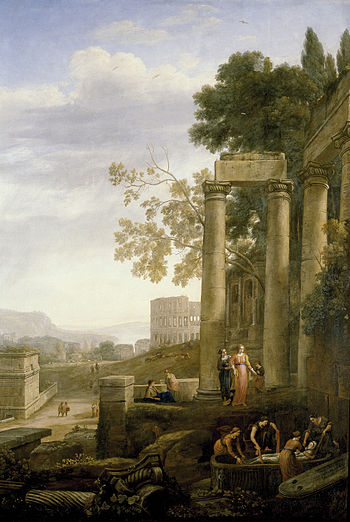1639–40 painting by Claude Lorrain
| This article needs additional citations for verification. Please help improve this article by adding citations to reliable sources. Unsourced material may be challenged and removed. Find sources: "Landscape with the Burial of St Serapia" – news · newspapers · books · scholar · JSTOR (February 2024) (Learn how and when to remove this message) |

Landscape with the Burial of St. Serapia is a 1639–40 oil painting by the French artist Claude Lorrain. It was one of several paintings commissioned from the artist on behalf of King Philip IV of Spain. It is now in the collection of the Prado Museum in Madrid, Spain.
The painting depicts the funeral of Saint Serapia, a slave to Saint Sabina, with Sabina and others in attendance. Serapia's martyrdom occurred in Vindena, now known to have been sited near Terni. At the time the painting was produced, it was thought to be located on the Aventine Hill, hence the Basilica of Santa Sabina.
In the painting, the inscription on the lid of the sarcophagus reads SEPVLTVRA.S.SABIN (a)... SEPELIR(e) IVBET.C.SANCTAE SERAPI(ae).
History
In 1637, various artists in Rome, including Claude Lorrain, were commissioned by the Marquis of Castelo Rodrigo, the ambassador to the Holy See, to create a series of paintings to doctorate the Buen Retiro Palace. This series of paintings depicted pastoral scenes and scenes of hermits in natural landscapes. Lorrain, along with Nicolas Poussin, were also commissioned to create an addition four landscapes. Poussin painted a pair of mythological scenes, Meleager's Hunt and The Feast of Priapus. Lorrain painted pair of scenes of the lives of the saints, Landscape with the Burial of St Serapia and Landscape with St Paula of Rome Embarking at Ostia.
References
- Buendia, Jos'e Rogelio; Valdovinos, José Manuel Cruz; Pastor, Ismael Gutiérrez; Folguera, José Miguel Morales; José Luis Morales Y, Marín; García, Wifredo Rincón (1994). Paintings of the Prado. Boston: Bulfinch Press. p. 489. ISBN 0-8212-2235-X.
| Claude Lorrain | |
|---|---|
| Paintings |
|
| Drawings |
|
This article about a seventeenth-century painting is a stub. You can help Misplaced Pages by expanding it. |